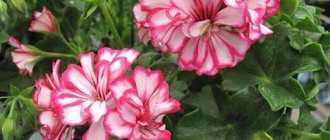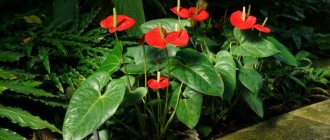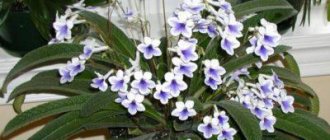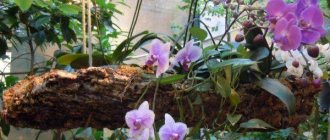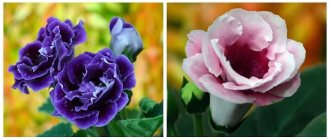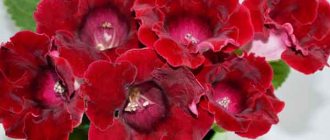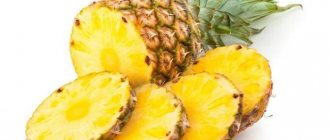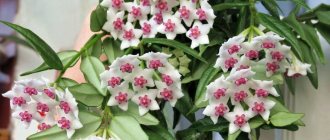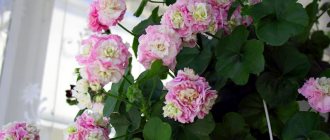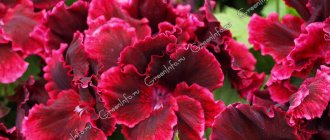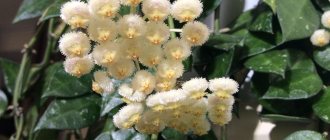Hoya - home care, photo, flowering
Hoya - home care, photo, flowering
Homeland of the plant
. East and Southeast Asia, Australia.
Description
. Hoya or wax ivy is a perennial, evergreen plant with climbing, thin, long shoots. The leaves are green, fleshy, simple, glossy, elliptical, bent along the central vein. Round inflorescences are formed on shoots 2.5–6 cm long and consist of many attractive flowers with a diameter of up to 1.5 cm each. The color range of the plant is very diverse and includes white, soft pink, orange, yellow, burgundy, purple and even almost black shades. Blooming hoya fills the house with a charming aroma, especially in the evening. Variegated varieties delight the eye not only with attractive inflorescences, but also with leaves that have yellow and white spots.
Hoya carnosa, fleshy – Hoya carnosa
An epiphytic liana with stems up to 6 m long. The leaves are green, simple, fleshy, oblong-lanceolate, opposite, slightly bent along the central vein. The flowers are white or pink with a burgundy center, collected in inflorescences - umbrellas, fragrant. Each umbrella can bear up to 30 flowers. This subspecies includes the variegated Hoya Tricolor - Hoya carnosa Tricolor, which has very bright leaves, painted dark green with large white, pink or yellowish spots in the center of the leaf blade.
Hoya Kerry – Hoya Kerrii
An increasingly popular variety with unusual thick leaves in the shape of an inverted heart. The leaves are opposite, green, but there are variegated plants with white stripes on the leaf blades. The flowers are greenish-white or cream, with a burgundy center and pubescent petals.
Hoya Bella, beautiful – Hoya Bella
The plant has tough, often even erect shoots. The leaves are oblong - lanceolate, simple, opposite, green, bent along the central vein. Inflorescences - umbels contain many small, attractive flowers with white or pinkish petals and a pink center. Often grown as an hanging plant.
Hoya lacunosa – Hoya lacunosa
A liana with thin stems and simple, lanceolate, light green leaves on short petioles. The flowers are delicate, cream-colored, with a yellow center, have a pleasant aroma, intensifying at night, and are collected in inflorescences - umbrellas. Within this subspecies, Hoya "Eskimo" - Hoya Lacunosa Eskimo - has become widespread. This is a plant with dense, glossy, silver-green speckled leaves and white flowers with pubescent petals.
Hoya multiflora – Hoya multiflora
This species has tough, low, often erect shoots with oblong-lanceolate, glossy, green leaves arranged in opposite pairs. The main distinguishing feature of this bush is its large, convex flowers that resemble arrows. The flower petals are colored orange, yellowish or greenish.
Hoya compacta - Hoya compacta
A very showy species with green, beautifully arching leaves. The leaves are green, glossy, and cover the thick stems so tightly that they give the impression of an intertwined rope. The white stripes along the edge of the leaf blade give variegated varieties a special attractiveness. The inflorescences are large, spherical, white or pinkish-orange with a darker center.
Hoya macrophylla - Hoya macrophylla
These plants can rather be classified as decorative foliage than flowering. The inflorescences are pink, loose and few-flowered umbrellas; the foliage gives the plant its main attractiveness. The leaf blades are glossy, painted in a wide variety of colors - all shades of green, white, yellow, pink, burgundy. The veins of the leaves are often highlighted in contrasting shades and the overall leaves can resemble the foliage of precious orchids.
Hoya Australis – Hoya Australis
An evergreen plant is a vine with thin shoots reaching a length of 10 m. and green glossy leaves. The leaves are simple, opposite, oblong-oval. Inflorescences - umbrellas bear many cream flowers with a sweetish aroma. The flowers have 5 thick, fleshy petals and have a burgundy circle in the center.
Hoya Mathilde – Hoya Mathilde
Often grown as a hanging plant, it has attractive, slender, pendulous stems that hang over the edge of the pot. The leaves are opposite, green or silvery green, broadly lanceolate, glossy. The inflorescences are spherical, white or soft pink, the flowers have a darker ring in the center.
Hoya Publicis – Hoya pubicalyx
This variety has very brightly colored flowers, often in dark shades - burgundy or dark gray with a burgundy center. The inflorescences reach a diameter of 10 cm. The leaves can be either simple, green, or have silver specks. The leaf blades are thick and fleshy.
Hoya "Crimson Queen" - Hoya Krimson Queen
A very delicate variety, the leaves of which often have white or soft pink stripes along the edges of the leaf blades. The flowers are soft pink, with a burgundy center.
Hoya obovata – Hoya obovata
The plant is a vine with thin and flexible shoots. The leaves are almost round in shape, thick, light green, on short petioles, arranged oppositely - in pairs. The flowers are greenish, pink or pink, with thick, pubescent petals.
Height
. The stems of indoor Hoya reach a length of 3 m and grow quickly.
Temperature conditions
. Choose a room with a normal room temperature of 18 – 22° C to grow the plant throughout the year. In the winter months, the room temperature should not fall below 10 - 12 ° C. A cool dormant period is not a prerequisite, but is desirable for the onset of flowering.
Growing Hoya - Lighting
. These plants require a lot of sunlight to develop properly. If they grow in poorly lit areas, they become thin and develop less colorful flowers. Direct sun can burn the foliage. Variegated varieties require brighter lighting than green varieties. When grown in partial shade, the leaf color often becomes dark.
How to care for pruning Hoya
. If you create favorable conditions for your hoya, then in the summer on a sunny windowsill it will bloom with beautiful, large inflorescences. After flowering, do not cut the flower stems - next year new flowers will appear on them again. Provide vertical support for the plant or wrap the stems around a rounded trellis.
Soil for hoya
. You need very porous, well-drained soil with a slightly acidic pH. As a top layer, it is better to surround the caudex with small pebbles or coarse sand to avoid rotting.
Fertilizer for hoya
. When growing, use fertilizers with a high potassium content (or balanced), feed every 2 weeks, the plants respond well to feeding! During the dormant period, feeding is stopped.
Purpose
. Great for both vertical gardening and hanging pots.
Hoya flowering time
. Flowering lasts throughout the summer, but occurs only with proper care.
Air humidity
. High, regular spraying is required.
Watering
. In spring and summer, watering should be plentiful, but between them the soil should dry out to a depth of several centimeters. The indoor plant Hoya easily tolerates short-term drought, but will not tolerate stagnant moisture in the soil. If the flower grows in a warm room where the temperature is above 15 C, it should be watered regularly, even during the winter months. When kept cool, Hoya should be in almost dry soil.
Botanical information about the plant
Hoya is an original climbing vine, which at home reaches up to 6 m in length. At first, the plant produces leafless brown stems. Sometimes they have a purple tint, but when aerial roots and foliage appear, they turn green.
Because Hoya is a climbing plant, older shoots become woody over time to support the weight of the new foliage.
The leaf blades of the plant are usually leathery in nature with moderate fleshiness. Each of them is coated with a substance resembling beeswax. The plate is painted green and strewn with small gray dots. Interestingly, different varieties and types of hoya have their own foliage size and shade. At a young age, the leaves have a gorgeous shine, but gradually become matte.
Hoya inflorescences are usually collected in umbrellas, which contain about 50 buds. They often differ in shape, although each of them has 5 rounded petals. The diameter of the bud is approximately 1 or 2 cm. Inside the flower there is a crown consisting of five original protrusions. She rises majestically above the delicate petals.
If you want to have a hoya with large inflorescences, it is advisable to pay attention to the “Imperial” variety. Each bud in it reaches approximately 8 cm.
Velvety inflorescences are often painted in the following colors:
- brown;
- white;
- green;
- pink;
- burgundy
Interestingly, the blossoming buds remain in the inflorescence for approximately 21 days, after which a new one appears in its place. The plant begins to bloom in late spring and ends in mid-autumn. At the same time, it emits a pleasant aroma that fills the living space.
People who are sensitive to various odors should be judicious when adding wax ivy to their home.
general information
Hoya is a genus of evergreen tropical vegetation consisting of vines and shrubs. It belongs to the subfamily Lastovnevye, the Kutrovye family, and the natural habitat of representatives of the genus is the territory of South and Southeast Asia, the western coastal zone of Australia and Polynesia.
The scientific name of the genus is associated with the English gardener Thomas Hoy, who worked in the greenhouses of the Duke of Northumberland, where he grew a variety of vegetation, primarily tropical. It was named after him.
The type specimen of Hoya obovata was discovered on the island of Butung, located near the southeastern part of Sulawesi (Indonesia). This vine can also be found in the flora of Indonesia (Sulawesi), India, Thailand and Fiji.
Description
Obovata is a vine that has climbing shoots and grows quickly:
- It has thick, fleshy foliage, round in shape, without noticeable veins.
- The color of the leaf blades is rich green, with light specks randomly located on the main background. There is a form of Hoya obovata - splash, the leaves of which are abundantly covered with splashes and variegata - the center of the plate is much lighter.
- Foliage diameter – 6-8 cm.
- In abundant light, obovata blooms luxuriously, and it produces umbrellas consisting of 2-3 dozen star-shaped flowers. They are fluffy, soft pink, with a dark crown in the center - pink or dark pink.
- The main flowering time is late spring.
Like other hoyas, obovata produces a large amount of nectar, only it is not dark in color, but colorless.
The flowers are fragrant, their aroma is sweetish, honey, with a slight echo of a fresh cut of radish. The smell intensifies noticeably at night.
A number of researchers believe that Hoya obovata is a hybrid species obtained by crossing Hoya carnosa and Hoya kerry.
Description of Hoya Obovata species with photos
Variegata
The flower grows and develops very quickly . The stems are large, climb well, and over time acquire a light brown tint. The leaves are large, lobed, light green, with a wide yellow-green stripe in the middle of the leaf. The leaves are voluminous in shape, round, dense, shiny, up to 8 – 9 cm in diameter.
Additional leaves are light green, covered with a silver scattering of small spots. The flower itself is two-tiered, the base is milky white, the crown is bright crimson. The main petals are pointed, slightly curled down, the crown has the shape of a five-pointed star.
On a note! The variegated variety of the flower has a tart, sweetish aroma, produces transparent nectar, and blooms quickly in May - early June.
With proper care, flowering continues for several months. Shape-forming pruning is required. Propagated in most cases by cuttings.
Splash
The variety is very popular and does not grow very quickly. The stems are long and require support to maintain the integrity of the root system . The stems are up to 0.5 cm in diameter, at the very beginning the shoots are reddish in color, then they acquire a woody structure and a brown tint.
The leaves are thick, dense, fleshy, shiny, round in shape, up to 6–8 cm in diameter. The leaf plate is covered with silver spots - stains, the leaf veins are practically not visible. The inflorescences are lush, rounded in shape, containing 25 - 30 small flowers.
The flowers are five-pointed, the petals are pointed, pale pink. The crown of the flower is darker - a rich pink - crimson hue. The flowers have a distinct sweet aroma. Blooms profusely in late spring.
Important! Regular pruning of stems is required.
To preserve variegated foliage, bright lighting without direct sunlight is required .
There are more than 200 varieties of wax ivy. We recommend that you learn about the peculiarities of cultivation, as well as look at photos of hoya species:
- Kurtisi;
- Australis;
- Linearis;
- Bella;
- Cumingiana;
- Lobby;
- Vayeti;
- Hoya Crimson Queen;
- Carnosa;
- Lacunose;
- Matilda.
Features of the care and maintenance of hoya are obovovat
The liana is unpretentious, however, we must not forget about its exotic origin and climatic preferences. The owner should take care of the following aspects:
Suitable soil mixture
The substrate should be light, nutritious, and well-permeable to water and air. You can purchase it at a flower shop or prepare it yourself by mixing the following products:
- 1 part of turf land.
- 1 part leaf soil.
- 4 parts peat.
- 1 part sand.
- 1 part humus.
You should definitely place drainage material at the bottom of the pot - sand with expanded clay, clay shards, brick chips, vermiculite, agroperlite. In extreme cases, pieces of foam plastic can be used for these purposes. Drainage will not allow moisture to stagnate at the root system of the flower and eliminate the likelihood of it rotting.
Temperature
Hoya obovata is a heat-loving plant that does not tolerate drafts and sudden temperature changes. In summer, the optimal indicator should vary in the range of +18 - +25 degrees; in hot weather it is recommended to spray the flower regularly.
In autumn and winter, obovata prefers to rest in the cool air. This means that, starting in autumn, the room temperature should be gradually lowered to a stable level of +12 to +15 degrees. It should not be allowed to drop to +10 degrees; such cold is destructive for obovata.
Watering mode
All hoyas need moisture constantly, regardless of the season. You can adhere to the following recommendations:
- Water the obovata when the top layer of the soil mixture dries out.
- In the warm season, water is added regularly, but little by little, and the foliage of the vine is also sprayed once a day.
- It is recommended to wipe the hoya leaves weekly with a soft, damp cloth.
- Purified or settled water is used, at room temperature. If it is hard, then it is advisable to soften it by adding sphagnum moss, charcoal or activated carbon.
Lighting requirements
Light is necessary, but it is desirable that it be diffused. If the vine is located on a south window, then in summer it should be shaded, protecting it from direct sun. Otherwise, the foliage may lose its brightness, become covered with burns or brown pigmentation.
This flower has a negative attitude towards change, both movement and sudden changes in light conditions. This may cause the plant to stop flowering or lose its leaves.
Trimming
It is recommended to cut off vines that are too long. This should be done with a disinfected instrument. The best time for the procedure is March. And since obovata is a fast-growing flower, you will have to trim the shoots and pinch out new shoots every year.
After the event, the plant acquires lateral buds, the bush becomes thicker and blooms more luxuriously.
But you shouldn’t touch the peduncle, as new inflorescences appear on it.
How and what to feed obovata?
The flower is fertilized during the active growing season, when it grows and blooms - from early spring to late summer. 2 times a month is enough.
Complex mineral mixtures are suitable for these purposes. Blooming Hoya can be fed with a nutrient solution for flowering succulents, just dilute it in more water.
Landing Features
Several seedlings can be planted in one container; they form a dense, beautiful shrub. Long stems require additional support so that the root system is not damaged under the weight of the heavy above-ground part of the plant.
How to propagate Hoya obovata at home?
There are several methods for propagating tropical vines at home, and each of them has both its advantages and disadvantages.
Planting seeds
Gardeners usually do not use this method for growing indoor Hoya obovata. They resort to it when growing vines in greenhouses, where there is a humid microclimate suitable for sowing. The sowing process is as follows:
- The seeds are dried in air.
- Burlap or some artificial fibers are added to the soil.
- Within a week to a week and a half, the seeds germinate.
Care errors
Hoya obovata sheds its leaves - a consequence of three “over-”: rearrangement and/or hypothermia and/or waterlogging.
If possible, the vine should not be moved, the temperature and humidity conditions should be optimized, and cold water should not be used for irrigation.
Lack of flowering - low illumination, warm wintering. Lighting should be increased and winter storage should be organized in a cool place.
The plant sheds buds and flowers - rearrangement or dry and heated air. We should not forget that Hoya obovata is a “fixed place” plant that needs summer spraying.
Slow growth, pale leaves are a consequence of lack of nutrition; replanting is required.
Diseases and pests are common
Most of all, the vine is afraid of stagnant water and waterlogging of the soil. These maintenance violations can lead to the development of root and stem rot. The flower is especially vulnerable during the winter holidays; excess moisture against the background of cold can greatly harm it.
Hoya can be cured of these fungal diseases using fungicidal drugs.
To prevent fungus and other infections, it is recommended to periodically treat the soil and foliage with a solution of Bordeaux mixture. In summer, you can bathe the obovata under a warm shower and then remove excess moisture. Hoya obovata can be affected by scale insects, spider mites, whiteflies or aphids. They are removed manually, the foliage is treated with a solution of laundry soap or diluted alcohol. In case of severe damage, the use of insecticides will be required.
2. Hoya care at home
2.1.Reproduction
Most often, vegetative propagation or cuttings .
Propagated by stem cuttings 8–10 cm long , each of them should have two pairs of leaves.
- The bases of the cuttings are rinsed with running water to remove any released juice.
- The cuttings in the lower part are dusted with rooting powder.
- To reduce moisture loss, remove the lower leaves.
- For planting, prepare small cups or pots with drainage holes.
- A drainage layer about 3 cm high is placed at the bottom of the pots.
- Fill the containers with nutritious and loose substrate.
- The bases of the cuttings are immersed in well-moistened soil with a high sand content. Instead of soil, you can use moistened perlite or vermiculite.
- Young plants are placed in a warm and well-lit place without access to direct sunlight under a cover made of transparent plastic or polyethylene.
The first roots can be noticed within a few days, and at a temperature of about 20°C, rooting will take 1.5 - 2 months .
The tops of young plants are pinched 4 leaves appear .
Plants obtained from cuttings will bloom only at the age of 4 years .
You can root Hoya cuttings even in a glass of water .
Leaf cuttings can also be used for vegetative propagation . For this method, the leaf is separated from the mother plant along with the petiole and the base of the petiole is dusted with growth hormones.
Leaf cuttings take longer to root than stem cuttings.
Rooting also takes place successfully in plain water, but plants that are then planted in the ground experience stress from sudden changes in conditions and are inhibited in growth.
by air layering works well ; for this, the long stems of the plant are pinned to the surface of the soil and lightly sprinkled with soil. The top of the shoot should be above the ground.
After some time, roots will appear in the leaf node. The successful completion of the rooting process will be indicated by the appearance of new growth.
Young cuttings are separated from the mother plant when they have already formed a good root system and have a sufficiently developed above-ground part.
Small plants are planted in cramped pots - in such conditions they develop faster and are less likely to rot. Several such transplants will be required for each plant.
You can get hoya from seeds , but for this you will have to be patient; in addition, only fresh planting material has good germination.
Seeds are sown in spring using a transparent plastic container with a lid.
- Drainage holes are made at the bottom of the container.
- The first layer is laid out with expanded clay drainage.
- Fill the container with a loose and nutritious, light substrate - a mixture of peat and river sand in equal quantities is suitable.
- The soil is well moistened from a spray bottle with water at room temperature.
- Containers with seedlings are kept in a warm place, shaded from direct sunlight.
- The container with seeds is covered with a lid to maintain uniformly high air humidity.
In such greenhouse conditions, the first shoots can be noticed within 1 - 2 weeks .
With the appearance of the first shoots, the cover is removed daily for a few minutes and condensation is removed from it. Gradually, the ventilation time is increased, hardening the seedlings.
Young plants develop rather slowly.
Picking into separate cups is carried out with the appearance of the first true leaves - when the seedlings are about 3 months .
Reproduction
Hoyas of this species are most often and easiest to propagate by cuttings and stem layering. Reproduction by leaves and seeds is much more difficult.
Propagation by seeds
Seeds are not produced on indoor hoyas. However, the seed must be fresh: seed germination quickly decreases.
The pod with seeds is slightly dried and then sown in a very loose, moistened substrate with a significant admixture of sphagnum. Shoots, as a rule, appear quickly, during the first week, but after this, young hoyas face the main danger: waterlogging, rotting and death.
This is all the more likely since the germination and development of seedlings requires warmth, high humidity, and good lighting. Spraying with Bordeaux mixture is useful for the prevention of fungal diseases. After about 3 months, after several pairs of true leaves appear, the seedlings are planted in separate containers.
Propagation by cuttings
This is the easiest method of propagation: in spring or summer, short cuttings are cut, on which there are two growth nodes and a few leaves. The lower cut is treated with a root formation stimulator and placed in a dark vessel with water so as to submerge the lower node. It is also advisable to increase air humidity.
Within two weeks, roots form, after which the cuttings are planted in a container with drainage and soil mixture.
You can root cuttings directly in the ground . To do this, adding coarse sand or perlite, prepare a soil mixture with increased moisture permeability. A cutting is placed in it, treated along the lower cut with a root formation stimulator, buried down to the first node and germinated at high air humidity for two to three weeks.
obtained by cuttings blooms in the fourth year.
Reproduction by stem layering
For this method of propagation an old shoot is cut , the cut site is surrounded with moist sphagnum and wrapped in polyethylene.
When roots form and grow through the sphagnum, the upper part of the shoot, along with the moss and root system, is planted in a separate container.
The resulting seedling blooms in the first year.
Leaf propagation
Reproduction by a leaf with a single axillary bud is possible; it is carried out in the same way as rooting a cutting directly in the ground, but it is more difficult ; often the root system develops very slowly, growth seems to freeze at the initial stage of one leaf and one bud.
